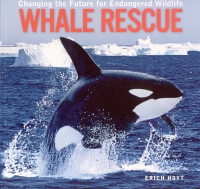| ________________
CM . . .
. Volume XII Number 10 . . . .January 20, 2006
excerpt:
Recognized whale expert, Erich Hoyt brings his extensive experience with whale research to this latest title in the “Firefly Animal Rescue” series. Despite the obvious difficulties of whale study - many species have yet to be examined in any detail - you'll read about the most up-to-date research here. In the introduction, and several additional pages, the author sketches whale facts including habits, habitat and migration, human hunting history and hazards faced by the animals. Since whaling bans only came into effect in some countries in the 1970s, it has taken a couple of decades to begin to see recovery in at least one species, the gray whale. By 1998, whale-watching became more lucrative for some than hunting, and in this new millennium, international sanctuaries are being established or proposed. In keeping with the format of the series, this book presents background information, followed by accounts of ongoing conservation work with close-up focus on several species: gray, humpback, blue, sperm and right whales. Individual profiles of scientists around the world show the extent of their efforts to bring the plight of the world's whales to the attention of governments and the public at large. Fascinating methods are described: photographic identification, genetic sampling for population studies, satellite tagging to help determine migration routes. On the education front, one example is the work of Japanese naturalist Hal Sato, who has set up a whale-watching business to try and change her country's attitudes toward whaling. High quality photographs add to the book's appeal. The orca on the cover may symbolize the controversy surrounding whale captivity to many readers. The author sees no purpose in this practice other than entertainment. He points out the unnatural social situation for orcas from different family groups being kept in tanks which are "little more than bathtubs," and he asserts that captive breeding of these unrelated orcas cannot help wild populations replenish their numbers. He offers both sides of the issue concerning protest group tactics to draw attention to the need for whale conservation. A final plea is made to recognize the potentially irreversible harm done to whale populations by noise pollution, toxins in the oceans, overfishing and entanglement in fishing gear, and interference from boats. When reprinted, one error needs attention: the Table of Contents' listing for page 28, Out of the Blue, should include the subheading "On the Frontlines" rather than "At Work." Add this informative book to the growing collection of works for young readers on endangered species. The list of organizations at the back encourages further learning about the problem with respect to whales. Highly Recommended. BC’s Gillian Richardson is a freelance writer and former teacher-librarian.
To comment
on this title or this review, send mail to cm@umanitoba.ca.
Copyright © the Manitoba Library Association. Reproduction for personal
use is permitted only if this copyright notice is maintained. Any
other reproduction is prohibited without permission.
NEXT REVIEW |
TABLE OF CONTENTS FOR THIS ISSUE
- January 20, 2006.
AUTHORS |
TITLES |
MEDIA REVIEWS |
PROFILES |
BACK ISSUES |
SEARCH |
CMARCHIVE |
HOME |
